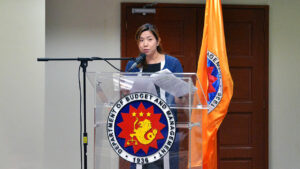By Luisa Maria Jacinta C. Jocson, Reporter
THE BANGKO SENTRAL ng Pilipinas (BSP) kept interest rates steady for a sixth straight meeting on Thursday but signaled that a rate cut at its next meeting in August is “somewhat more likely than before,” with up to 50 basis points (bps) in easing likely this year.
The Monetary Board on Thursday left its target reverse repurchase rate unchanged at 6.5%, the highest in over 17 years. This was in line with the expectations of all 15 analysts in a BusinessWorld poll last week.
Interest rates on the overnight deposit and lending facilities were also maintained at 6% and 7%, respectively.
Mr. Remolona said he expects inflation to further ease in the second semester with the implementation of lower tariffs on rice.
“The balance of risks to the inflation outlook has shifted to the downside for 2024 and 2025 due largely to the impact of lower import tariffs on rice under Executive Order (EO) No. 62,” he said at a press briefing.
“If sustained, an improvement in the inflation outlook would allow more scope to consider a less restrictive monetary policy stance.”
President Ferdinand R. Marcos, Jr. earlier this month signed EO 62 which slashed tariffs on rice imports to 15% until 2028 to tame rice prices.
Mr. Remolona said that inflation is “moving closer” to the midpoint of its 2-4% target, adding that expectations are still well-anchored.
The central bank slashed its risk-adjusted inflation forecast for this year to 3.1% from 3.8% previously. It also cut its risk-adjusted estimate for 2025 to 3.1% from 3.7% earlier.
Meanwhile, it lowered its average baseline inflation forecast for 2024 and 2025 to 3.3% and 3.1%, respectively, from 3.5% and 3.3%, previously.
“Nonetheless, higher prices of food items other than rice, transport charges, and electricity rates continue to pose upside risks to inflation,” Mr. Remolona said. “Meanwhile, prospects for domestic output growth remain in line with medium-term trends amid favorable labor market conditions and strong net exports.”
He said the Monetary Board is “on track” to cut rates when it next meets on Aug. 15. This will likely be ahead of the US Federal Reserve which earlier signaled it may start easing in December.
“Last time I said we’re still hawkish, but less so. We’re basically in the same position now. Somewhat more dovish than before,” Mr. Remolona said.
The BSP could cut rates by 25 basis points (bps) in the third quarter and by another 25 bps in the fourth quarter, he added.
The Monetary Board’s Aug. 15 review is its only meeting in the third quarter. Meanwhile, its last two reviews for the year will be held in the fourth quarter and are scheduled on Oct. 17 and Dec. 19.
TOO EARLY TO CUT?Analysts noted the more dovish signals from the BSP compared with its previous meetings.
“Tellingly, the read-out this time didn’t contain any language about how policy needs to be ‘sufficiently tight,’ saying instead that an improvement in the inflation outlook going forward would allow for some scope for policy to be ‘less restrictive,’” Pantheon Chief Emerging Asia Economist Miguel Chanco said in an e-mail note.
HSBC economist for ASEAN (Association of Southeast Asian Nations) Aris D. Dacanay in a note said that the BSP’s tone is “perhaps slightly more dovish, not closing the possibility of it cutting ahead of the Fed.”
“We even think the BSP was even more confident than last time, reflecting the fact that monetary policy in the Philippines may be becoming more independent from the Fed, even if partially,” he added.
However, Mr. Dacanay said that August may still be too soon to loosen policy reins.
“We do not think inflation will be soft enough by the August meeting with the rice tariff rate cut needing time to work its way in reducing prices,” Mr. Dacanay said.
ANZ Research said in a report that it may be too early to cut rates as inflation is still hovering near the upper bound of the 2-4% target as “upside risks from food prices continue to linger.”
ANZ said it expects the central bank to start cutting rates in early 2025, “if inflation consistently moves towards the midpoint of the official target range in the first quarter of 2024.”
Meanwhile, Mr. Chanco still expects that the BSP will cut by 25 bps in August, in line with the BSP’s outlook.
“Our core view still is that the Board will start a gradual normalization of policy in August with a 25-bp rate cut, following this on with similar-sized reductions in the October and December meetings,” he added.
PESO INTERVENTIONMeanwhile, Mr. Remolona said the central bank is “occasionally” intervening in the peso.
“We’ve been watching the peso. We don’t want it to depreciate too sharply. We occasionally intervene. I think today (Thursday) we did intervene. We don’t want it to depreciate too sharply,” Mr. Remolona said.
The peso closed at P58.75 per dollar on Thursday, strengthening by 11 centavos from its P58.86 finish on Wednesday. Its close on Wednesday was its weakest finish in over 20 months.
However, Mr. Remolona said that the peso’s effect on inflation is “not very large.”
“We think the pass-through, which is what we call the effect of depreciation on inflation, is estimated at 0.36% per 1% depreciation (of the) peso. Since the beginning of the year, the peso has depreciated by 5.7%. So, 5.7% against 0.36%, that adds up to a total about 0.2% in inflation.”
Mr. Remolona said that the central bank is active in intervening when it “senses stress in the market.”
“But mostly we come in to slow down the tendency of the peso to depreciate sharply. We don’t come in every day,” he added.
The Development Budget Coordination Committee on Thursday raised its foreign exchange rate assumption to a range of P56-P58 this year, a higher band than its P55-P57 range previously.





